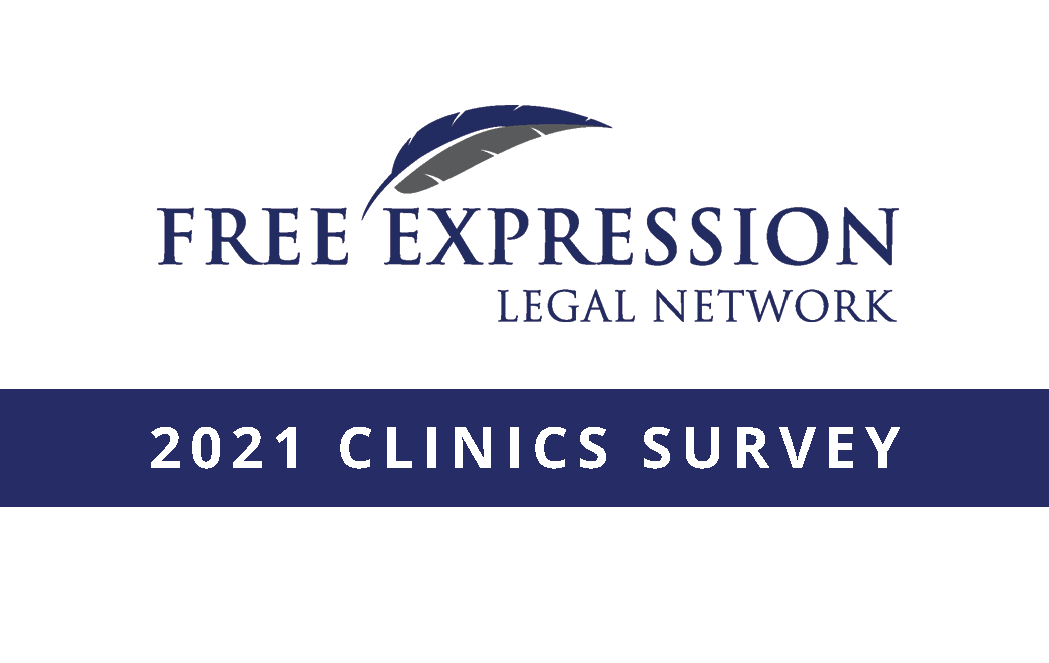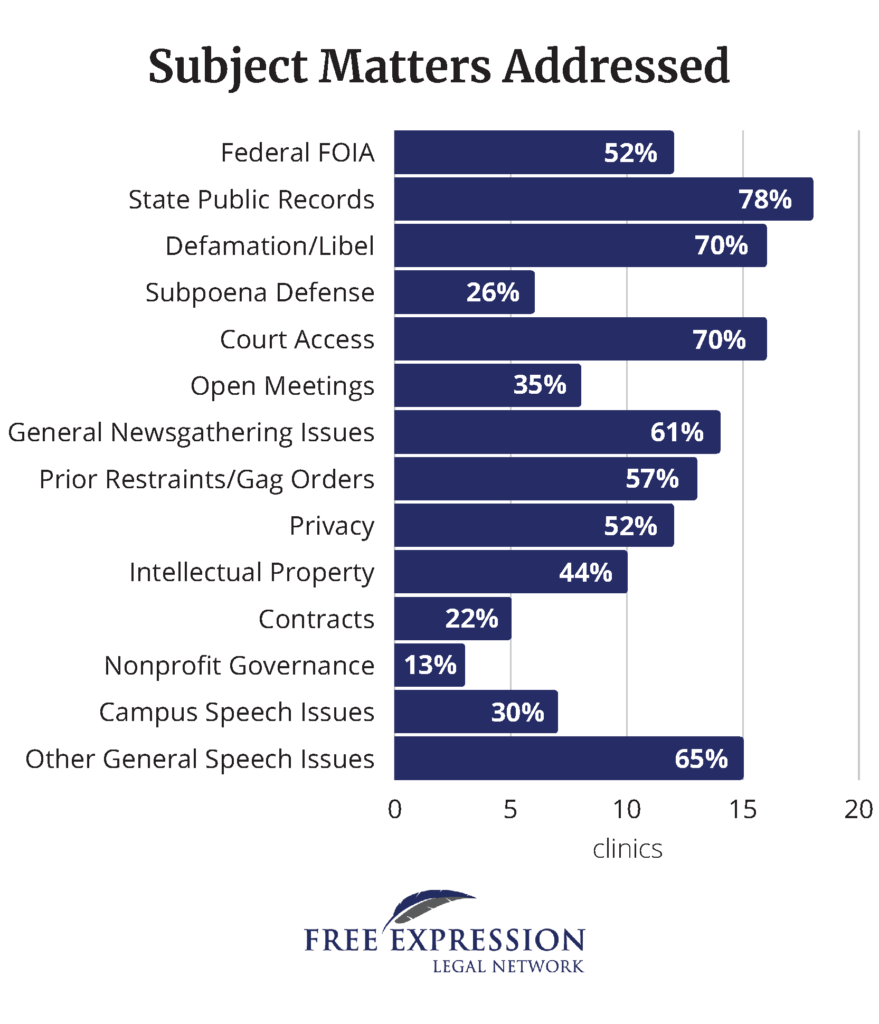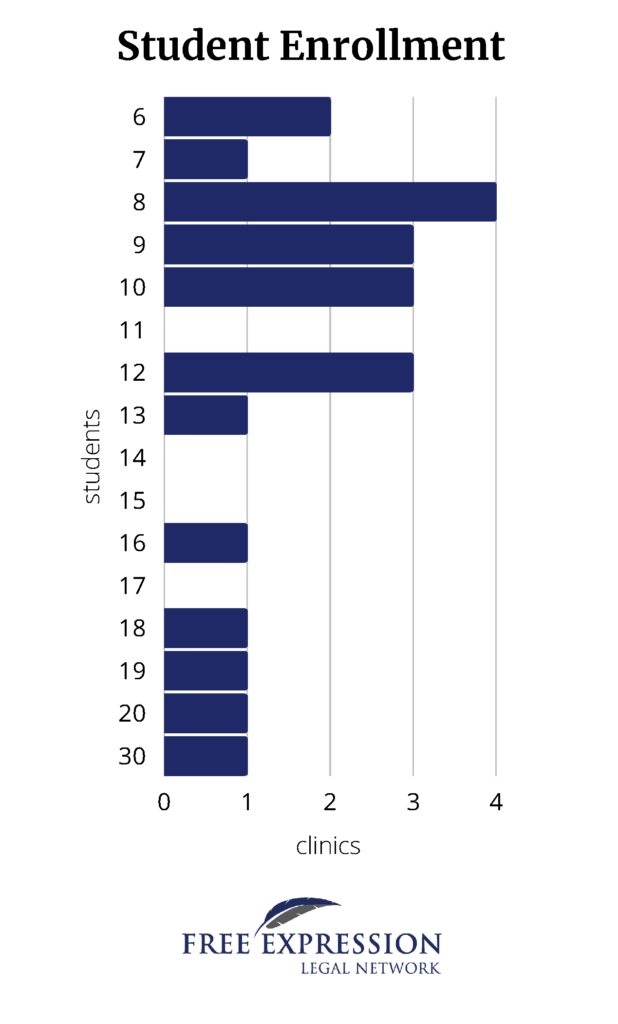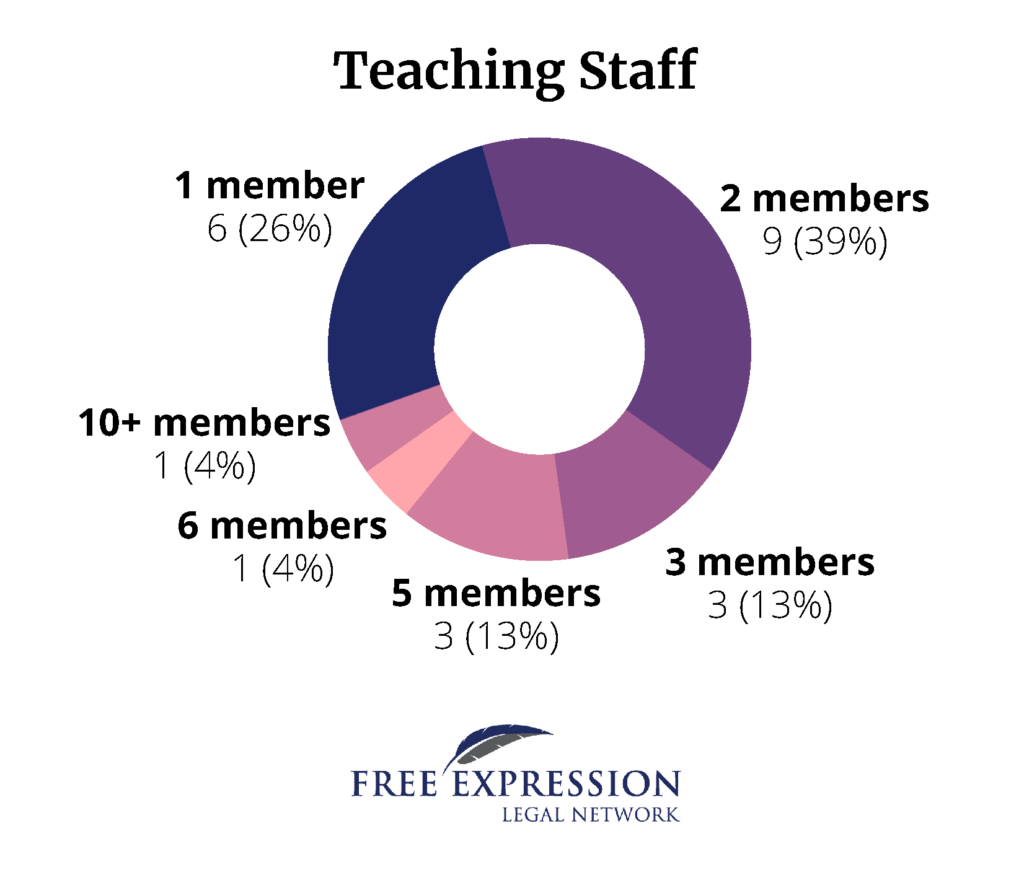First survey of FELN clinic members highlights subject matter focus, funding, biggest challenges

The number of law school clinics working on free speech, free press or government transparency issues (or a combination thereof) has continued to grow since FELN officially launched in 2019. The network — formed to help members collaborate and share resources to expand their impact — now numbers 32 clinics or similar organizations, plus two dozen law professors who do research and pro bono work in the space.
To better understand that membership, FELN circulated its first full clinics survey in the final three months of 2021. The information below represents the responses to that survey, on topics ranging from substantive focus to diversity initiatives to funding. A copy of the survey is available here.
As of publication, 23 of the 32 clinic members have responded. Most respondents are structured as traditional clinics at law schools, though two are other university-affiliated organizations that work on matters with law students. We will use “clinics” as shorthand below for all respondents.
The full list of FELN members, with links to their websites, is available on the right-hand side of FELN’s homepage.
Clinic information
Total responses: 23
Year clinic was founded
Many FELN clinics are relatively new, with 10 that launched in 2018 or later:
- 2018: Cornell, Duke, UCLA Doc Film, Vanderbilt
- 2019: Washington University
- 2020: Case Western Reserve, UGA, SMU, Tulane
- 2021: Columbia
The oldest clinic in the network is UVA, which launched in 1996. (It took a brief hiatus in 2017 before relaunching in 2019 in a partnership between UVA and the Reporters Committee.) Among the other respondents, the oldest clinics are generally tech-focused (Harvard, 1999; Berkeley, 2001; American, 2001; Colorado, 2007), and Yale’s access clinic, which started in 2009.
Substantive focus and clients
Primary substantive focus
FELN membership is not limited to those clinics working exclusively on free speech, free press or transparency issues; it also includes clinics that focus on other topics where their work overlaps with these issues. Among the respondents, their primary focus was:
- First Amendment: 11 (48%)
- IP/Technology: 6 (26%)
- Government Transparency: 2 (9%)
- Other: 4 (17%)

Geography
- 14 clinics (61%) accept clients nationwide, though some might only do so for certain types of matters or might put a priority on a specific state or region
- 9 clinics (39%) accept clients from only one or two states
Docket
Some clinics handle a variety of types of matters, while others focus predominantly on only one or two types. The following graph reflects the number of clinics working on each type of matter as related to free speech, free press or public records during the Fall 2021 semester. It then indicates the median percentage those matters take up on those clinics’ dockets.

Clinic Structure and Funding
Length
- 8 clinics (35%) require a full-year commitment
- 8 clinics (35%) are for one semester/quarter with an option to continue
- 6 clinics (26%) are for one semester/quarter
Number of credits per semester
Most respondents default to offering students either 4 credits per semester (9, 41%), 5 credits (4, 18%) or 6 credits (5, 23%). The remainder default to either 3 or 7 credits (2, 9% each).
More than half (12, 60%) do not give students any flexibility in the number of credits they receive. For those clinics that do provide flexibility, the credit offerings range from 1 to 8 credits, though 2 to 6 credits are more common than 1, 7 or 8 credits.
Number of students
The number of students enrolled per semester ranges from 6 to 30, with a median of 10. With some exceptions, generally the newer clinics have fewer students and the older clinics (which also are primarily tech-focused clinics) have more students.

Student selection
- 12 clinics (52%) select students based on an application specific to the clinic
- 7 clinics (30%) do not select particular students; students enroll without the clinic staff’s input
- 4 clinics (17%) select students based on a general application shared among multiple clinics
Pedagogical components
(respondents could select multiple)
- Weekly or biweekly class/seminar: 23 (100%)
- Bootcamp-style session at the beginning of the year or semester: 14 (61%)
- Weekly (or otherwise regular) case team meetings: 22 (96%)
- Individual one-on-one meetings with students: 18 (78%)
Outside funding
Three-quarters of clinics (18, 78%) indicated they receive at least some outside funding. Among that group, it goes toward:
- Staff salary: 17 (94%)
- Staff supplements (conference travel, etc.): 12 (67%)
- Litigation/case related costs: 13 (72%)
- Communications/marketing: 8 (44%)
- Administrative support (including administrator salaries): 8 (44%)
University funding
Almost three-quarters of clinics (16, 70%) indicated they receive at least some funding directly from the university. Among that group, it goes toward:
- Staff salary: 12 (75%)
- Staff supplements (conference travel, etc.): 10 (63%)
- Litigation/case related costs: 7 (44%)
- Communications/marketing: 9 (56%)
- Administrative support (including administrator salaries): 13 (81%)
Staffing and Funding
More than half of clinics have a teaching staff of either 1 or 2 staff members. The remaining clinics have a staff of either 3, 5 or 6, with ICAP at Georgetown as the outlier with 10 or more.

A minority of clinics have at least one tenured or tenure-track staff (5, 22%) or at least one clinical faculty with similar status (9, 39%). Conversely, three-fourths (17, 74%) have at least one lecturer, instructor, adjunct professor or staff in a similar position that is not tenured or tenure-track. Roughly half have at least one legal fellow (11, 48%).
The funding picture for teaching staff positions is a mixed bag. More than a third of clinics’ positions are funded entirely by term-limited or outside “soft” funds (9, 39%), less than a third of clinics’ positions are funded entirely by the university (7, 30%), and the remaining clinics’ positions are funded by a combination of both. In all, almost 60% of the 60+ positions at the 23 clinics are funded by term-limited or outside “soft” funds.
See more staffing breakdowns at the end of this post.
Capacity, Diversity and FELN
Capacity to support journalists
With the varied focus of FELN clinics as discussed above, not all of them specifically market themselves to journalists. Even still, most clinics said they have had to turn away at least one journalist or news organization due to a lack of capacity in the past year, and more than a third indicated they have done so with some frequency:
- At least once per week: 2 (9%)
- Two or three times per month: 4 (17%)
- Monthly or bimonthly: 3 (13%)
- Rarely, perhaps one to five times per year: 9 (39%)
- Never, we actively seek out journalists and news organizations for additional matters: 1 (4%)
- Did not answer/other: 4 (17%)
Biggest challenges
The most commonly identified challenge facing clinics this academic year is COVID-19, which still brings a lot of issues ranging from practice logistics to enrollment levels to childcare for staff. The other two commonly identified challenges were (1) bandwidth — not having enough staff to meet all potential needs and/or current staff members being stretched thin; and (2) fundraising — needing to raise money to maintain current staffing levels.
Efforts to promote diversity in staff hiring, student admission and/or case selection
The approaches by clinics to promote diversity vary widely. In staff hiring and student admissions, some respondents noted that they were limited to or relied upon the resources of their university (and some clinics do not play any role in selecting their students). Some clinics do affirmative outreach to affinity groups and underrepresented communities both on campus and within the legal profession, which helps create a more diverse pipeline of students and hires. Multiple clinics also participate in the Initiative for a Representative First Amendment, which was launched by the Harvard Cyberlaw Clinic and provides financial and career support for law students from underrepresented backgrounds and places them in an internship with a clinic.
When it comes to case selection, many clinics maintain relationships with community organizations and networks supporting underrepresented communities and journalists. Some examples include partnering with affinity journalism groups to provide legal training, hiring a consultant to promote services to diverse journalists, and proactively taking matters that promote the interests of underrepresented communities.
Client referral
96% indicated they would be interested in receiving referrals of potential clients or matters from FELN or other FELN members.
Conclusion
This survey is informative about the clinics landscape, and FELN will use the results as it continues to develop its programming and member resources in 2022. We also hope to make this an annual survey, so if there are additional things you would like to learn from the next survey, please let us know.
***
Additional Responses
Tenured or tenure-track faculty
- 0 employees: 18 (78%)
- 1 employee: 4 (17%)
- 2 employees: 0
- 3 employees: 1 (4%)
Clinical faculty with protection similar to tenure (or on track for such protection)
- 0 employees: 14 (61%)
- 1 employee: 8 (35%)
- 2 employees: 0
- 3 employees: 1 (4%)
Lecturer, instructor, adjunct professor, or similar position without security of position
- 0 employees: 6 (26%)
- 1 employee: 6 (26%)
- 2 employees: 8 (35%)
- 3 employees: 3 (13%)
Staff attorneys
- 0 employees: 14 (61%)
- 1 employee: 4 (17%)
- 2 employees: 3 (13%)
- 3 employees: 0
- 4 employees: 1 (4%)
- 5 employees: 0
- 6 employees: 0
- 7 employees: 0
- 8 employees: 1 (4%)
Legal fellows
- 0 employees: 12 (52%)
- 1 employee: 9 (39%)
- 2 employees: 2 (9%)
Number funded by university or other “hard” money
- 0 employees: 9 (41%)
- 1 employee: 7 (32%)
- 2 employees: 3 (14%)
- 3 employees: 2 (9%)
- 4 employees: 0
- 5 employees: 0
- 6 employees: 1 (5%)
Number funded by term-limited funds or outside “soft” funds
- 0 employees: 7 (32%)
- 1 employee: 7 (32%)
- 2 employees: 4 (18%)
- 3 employees: 2 (9%)
- 4 employees: 0
- 5 employees: 1 (5%)
- 6 employees: 0
- 7 employees: 0
- 8 employees: 0
- 9 employees: 0
- 10 or more employees: 1 (5%)